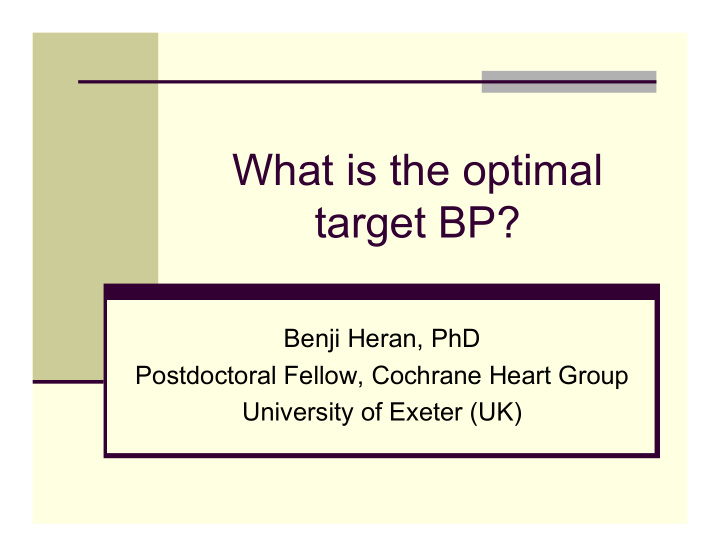



What is the optimal target BP? Benji Heran, PhD Postdoctoral Fellow, Cochrane Heart Group University of Exeter (UK)
Acknowledgements Dr. José Arguedas Dr. Marco Perez Dr. Jim Wright Cochrane Hypertension Review Group
Case 57 year old male diagnosed with hypertension 2 years ago (160/90 mmHg) In addition to eating healthy and exercising regularly, patient is taking maximal doses of thiazide and ACEI BP is 145/83 mmHg
Questions What is your target BP for this patient? What would be your next step in treating this patient? How many different classes of drugs would you prescribe to attempt to reach target? Answer the same questions if patient also had type 2 diabetes controlled with dietary measures.
Clinical Practice Guidelines Traditional BP target <140-160/90-100 mmHg CHEP 2010: BP target values for treatment of hypertension <140 systolic and <90 mmHg diastolic In diabetes, target <130 systolic and <80 mmHg diastolic Canadian Diabetes Association 2008: Persons with diabetes and hypertension should be treated to attain systolic BP <130 mmHg and diastolic BP <80 mmHg.
Question for Audience Do you think it is likely that patients with diabetes and renal disease are more likely to benefit from lower BP targets than other patients with hypertension?
Cochrane Method: Use ‘PICOS’ to create a question • P articipants - Describe the patient population. • I ntervention - Define the intervention. • C omparator – Define the comparator. • O utcome – Define specific outcome(s) • S tudy Design – Define study design. Usually RCTs.
Relevant question In people with elevated blood pressure, does a lower BP target as compared to a traditional BP target change mortality and morbidity in RCTs? Traditional BP target <140-160/90-100 mmHg
What evidence is required to answer this question? Trials in which patients with hypertension are randomized to the traditional target and one or more lower blood pressure targets. Must at least report one of the desired outcomes.
What outcomes are desired? Total mortality Total people with at least one serious adverse event (including cardiovascular SAEs and all other SAEs) Achieved differences in blood pressure
What evidence is available? 2 RCTs assessed two systolic BP targets 7 RCTs assessed two or more diastolic or mean BP targets
Achieved BP differences in 8 trials Systolic -5.8 [95% CI -6.2, -5.5] mmHg Diastolic -3.6 [95% CI -3.8, -3.4] mmHg
RevMan Forest Plot Total mortality in 8 RCTs RR 1.01 [95% CI 0.89, 1.14]
Morbidity None of the trials reported total SAEs Total MI in 4 RCTs RR 0.89 [95% CI 0.73, 1.08] Total stroke in 5 RCTs RR 0.85 [95% CI 0.70, 1.04] CHF in 5 RCTs RR 0.89 [95% CI 0.70, 1.12] End-stage renal disease in 4 RCTs RR 1.01 [95% CI 0.84, 1.23]
What proportion of patients failed to achieve BP targets in major trials? 40% of patients failed to achieve target diastolic of <90 mmHg. For systolic hypertension trials 35% of patients failed to achieve target systolic of <160 mmHg.
Back to Case What is your target BP for this patient? <90 mmHg diastolic and <160 mmHg systolic What is your target BP if patient also had type 2 diabetes? <90 mmHg diastolic and <160 mmHg systolic Available RCT evidence does NOT demonstrate that patients with diabetes and renal disease are more likely to benefit from lower BP targets than other patients with hypertension.
Conclusions In trials assessing systolic and diastolic targets large differences in BP have NOT been achieved. BP targets are difficult or impossible to achieve in many patients. BP targets less than the traditional target of <140-160/90-100 mmHg do not change mortality or morbidity.
Conclusions (cont) In managing hypertension BP targets should be those used in RCTs: <90 mmHg diastolic and <160 mmHg systolic. It is important to appreciate that these targets will not be achieved in a third of patients. More RCTs are needed.
Questions ?
Recommend
More recommend